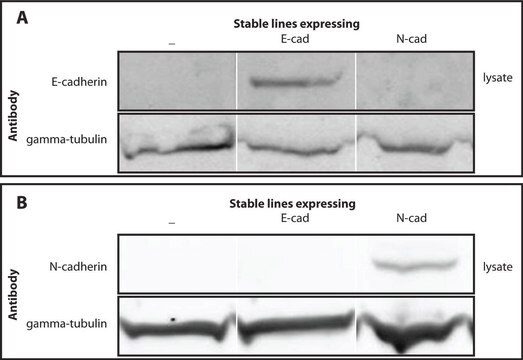MAB1864-I
Anti-alpha-Tubulin Antibody, tyrosinated, clone YL1/2
clone YL 1/2, from rat
Synonyme(s) :
Tubulin alpha-1A chain, Alpha-tubulin 3, Tubulin B-alpha-1, Tubulin alpha-3 chain, alpha-Tubulin, tyrosinated
About This Item
Produits recommandés
Source biologique
rat
Niveau de qualité
Forme d'anticorps
purified immunoglobulin
Type de produit anticorps
primary antibodies
Clone
YL 1/2, monoclonal
Espèces réactives
yeast, porcine, rat, chicken, bovine, human, mouse
Technique(s)
ELISA: suitable
electron microscopy: suitable
immunocytochemistry: suitable
immunohistochemistry: suitable
radioimmunoassay: suitable
western blot: suitable
Isotype
IgG2aκ
Numéro d'accès NCBI
Numéro d'accès UniProt
Conditions d'expédition
wet ice
Modification post-traductionnelle de la cible
unmodified
Informations sur le gène
human ... TUBA1A(7846)
Description générale
Spécificité
Immunogène
Application
µ
Representative lots detected phenylalaninated alpha-tubulin immunoreactivity in yeast and tyrosinated alpha-tubulin immunoreactivity in HEK293 cells (Kilmartin J.V., et al. (1982). J Cell Biol. 93(3):576-582; Bandyopadhyay, B., et al. (2007). J Biol Chem. 282(22):16454-16464).
Analyse par immunohistochimie : A representative lot detected microtubules tyrosinated alpha-tubulin immunoreactivity in mid-streak level section of Hamburger-Hamilton stage 4 (HH4) chick embryos (Nakaya, Y., et al. (2008).
Representative lots detected microtubules phenylalaninated alpha-tubulin immunoreactivity using crude yeast nuclear envelope preparations and microtubules tyrosinated alpha-tubulin immunoreactivity in NIH/3T3 cells (Wehland, J., and Willingham, M.C. (1983). J Cell Biol. 97(5 Pt 1):1476-1490; Kilmartin J.V., et al. (1982).
The antigenicity of clone YL1/2 was determined by competitive ELISA using pig brain-derived tubulin against alpha-tubulin peptides with or without Tyr/Phe at the C-terminal end (Wehland, J., et al. (1984).
The immunoreactivity of clone YL1/2 toward chick brain tubulin and yeast tubulin was determined by radioimmunoassays (Kilmartin J.V., et al. (1982). J Cell Biol. 93(3):576-582).
Structure cellulaire
Molécules d'adhésion cellulaire (CAM)
Qualité
µµ
Description de la cible
Forme physique
Stockage et stabilité
Autres remarques
Clause de non-responsabilité
Not finding the right product?
Try our Outil de sélection de produits.
Code de la classe de stockage
12 - Non Combustible Liquids
Classe de danger pour l'eau (WGK)
WGK 1
Point d'éclair (°F)
Not applicable
Point d'éclair (°C)
Not applicable
Certificats d'analyse (COA)
Recherchez un Certificats d'analyse (COA) en saisissant le numéro de lot du produit. Les numéros de lot figurent sur l'étiquette du produit après les mots "Lot" ou "Batch".
Déjà en possession de ce produit ?
Retrouvez la documentation relative aux produits que vous avez récemment achetés dans la Bibliothèque de documents.
Les clients ont également consulté
Notre équipe de scientifiques dispose d'une expérience dans tous les secteurs de la recherche, notamment en sciences de la vie, science des matériaux, synthèse chimique, chromatographie, analyse et dans de nombreux autres domaines..
Contacter notre Service technique












